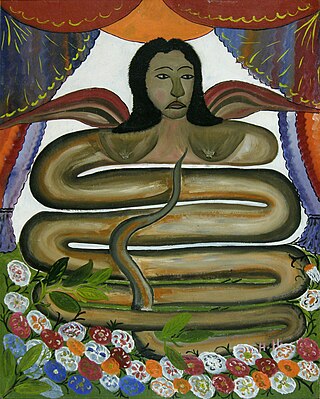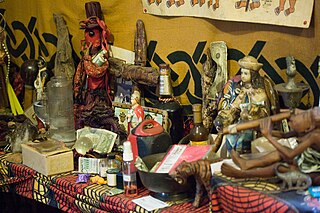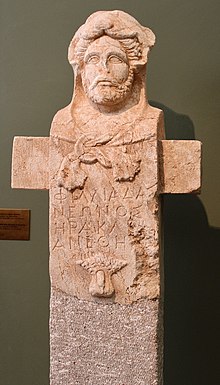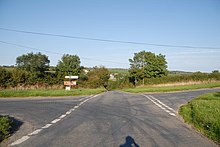
Lwa, also called loa, are spirits in the African diasporic religion of Haitian Vodou. They have also been incorporated into some revivalist forms of Louisiana Voodoo. Many of the lwa derive their identities in part from deities venerated in the traditional religions of West Africa, especially those of the Fon and Yoruba.
A mojo, in the African-American spiritual practice called Hoodoo, is an amulet consisting of a flannel bag containing one or more magical items. It is a "prayer in a bag", or a spell that can be carried with or on the host's body. Alternative American names for the mojo bag include gris-gris bag, hand, mojo hand, toby, nation sack,conjure hand, lucky hand, conjure bag, juju bag, trick bag, tricken bag, root bag, and jomo. The word mojo also refers to magic and charms. Mojo containers are bags, gourds, bottles, shells, and other containers. The making of mojo bags in Hoodoo is a system of African-American occult magic. The creation of mojo bags is an esoteric system that involves sometimes housing spirits inside of bags for either protection, healing, or harm and to consult with spirits. Other times mojo bags are created to manifest results in a person's life such as good-luck, money or love.

Robert Leroy Johnson was an American blues musician and songwriter. His landmark recordings in 1936 and 1937 display a combination of singing, guitar skills, and songwriting talent that has influenced later generations of musicians. Although his recording career spanned only seven months, he is recognized as a master of the blues, particularly the Delta blues style, and one of the most influential musicians of the 20th century. The Rock and Roll Hall of Fame describes him as perhaps "the first ever rock star".

Vodun is a religion practiced by the Aja, Ewe, and Fon peoples of Benin, Togo, Ghana, and Nigeria.
Spirit possession is an unusual or an altered state of consciousness and associated behaviors which are purportedly caused by the control of a human body and its functions by spirits, ghosts, demons, angels, or gods. The concept of spirit possession exists in many cultures and religions, including Buddhism, Christianity, Haitian Vodou, Dominican 21 Divisions, Hinduism, Islam, Wicca, and Southeast Asian, African, and Native American traditions. Depending on the cultural context in which it is found, possession may be considered voluntary or involuntary and may be considered to have beneficial or detrimental effects on the host. Spirit possession is often regarded as a reason in support of spirits, deities or demons. In a 1969 study funded by the National Institute of Mental Health, spirit possession beliefs were found to exist in 74% of a sample of 488 societies in all parts of the world, with the highest numbers of believing societies in Pacific cultures and the lowest incidence among Native Americans of both North and South America. As Pentecostal and Charismatic Christian churches move into both African and Oceanic areas, a merger of belief can take place, with demons becoming representative of the "old" indigenous religions, which the Christian ministers attempt to exorcise.

Papa Legba is a lwa in Haitian Vodou, Dominican Vodou, Winti and Louisiana Voodoo, who serves as the intermediary between God and humanity. He stands at a spiritual crossroads and gives permission to speak with the spirits of Guineé, and is believed to speak all human languages. In Haiti, he is the great elocutioner. Legba facilitates communication, speech, and understanding. He is commonly associated with dogs. Papa Legba is invoked at the beginning of every ceremony. Papa Legba has his origins in the historic West African kingdom of Dahomey, located within present-day Benin.
Èṣù is a pivotal Òrìṣà/Irúnmọlẹ̀ in the Yoruba spirituality known as ìṣẹ̀ṣe. Èṣù is a prominent primordial Divinity who descended from Ìkọ̀lé Ọ̀run, and the Chief Enforcer of natural and divine laws - he is the Deity in charge of law enforcement and orderliness. As the religion has spread around the world, the name of this Orisha has varied in different locations, but the beliefs remain similar.

Orishas are divine spirits that play a key role in the Yoruba religion of West Africa and several religions of the African diaspora that derive from it, such as Cuban, Dominican and Puerto Rican Santería and Brazilian Candomblé. The preferred spelling varies depending on the language in question: òrìṣà is the spelling in the Yoruba language, orixá in Portuguese, and orisha, oricha, orichá or orixá in Spanish-speaking countries.

Hoodoo is a set of spiritual practices, traditions, and beliefs that were created by enslaved African Americans in the Southern United States from various traditional African spiritualities and elements of indigenous botanical knowledge. Practitioners of Hoodoo are called rootworkers, conjure doctors, conjure men or conjure women, and root doctors. Regional synonyms for Hoodoo include rootwork and conjure. As a syncretic spiritual system, it also incorporates beliefs from Islam brought over by enslaved West African Muslims, and Spiritualism. Scholars define Hoodoo as a folk religion. It is a syncretic religion between two or more cultural religions, in this case being African indigenous spirituality and Abrahamic religion.

Nana Buluku, also known as Nana Buruku, Nana Buku or Nanan-bouclou, is the female supreme being in the West African traditional religion of the Fon people and the Ewe people (Togo). She is one of the most influential deities in West African theology, and one shared by many ethnic groups other than the Fon people, albeit with variations. For example, she is called the Nana Bukuu among the Yoruba people and the Olisabuluwa among Igbo people but described differently, with some actively worshiping her while some do not worship her and worship the gods originating from her.
Haitian mythology consists of many folklore stories from different time periods, involving sacred dance and deities, all the way to Vodou. Haitian Vodou is a syncretic mixture of Roman Catholic rituals developed during the French colonial period, based on traditional African beliefs, with roots in Dahomey, Kongo and Yoruba traditions, and folkloric influence from the indigenous Taino peoples of Haiti. The lwa, or spirits with whom Vodou adherents work and practice, are not gods but servants of the Supreme Creator Bondye. A lot of the Iwa identities come from deities formed in the West African traditional regions, especially the Fon and Yoruba. In keeping with the French-Catholic influence of the faith, Vodou practioneers are for the most part monotheists, believing that the lwa are great and powerful forces in the world with whom humans interact and vice versa, resulting in a symbiotic relationship intended to bring both humans and the lwa back to Bondye. "Vodou is a religious practice, a faith that points toward an intimate knowledge of God, and offers its practitioners a means to come into communion with the Divine, through an ever evolving paradigm of dance, song and prayers."

The Kalûnga Line in Kongo religion is a watery boundary between the land of the living and the spiritual realm of the ancestors. Kalûnga is the Kikongo word "threshold between worlds." It is the point between the physical world and the spiritual world. It represents liminality, or a place literally "neither here nor there." Originally, Kalûnga was seen as a fiery life-force that begot the universe and a symbol for the spiritual nature the sun and change. The line is regarded as an integral element within the Kôngo cosmogram.

Louisiana Voodoo, also known as New Orleans Voodoo, is an African diasporic religion that originated in Louisiana. It arose through a process of syncretism between the traditional religions of West Africa, the Roman Catholic form of Christianity, and Haitian Vodou. No central authority is in control of Louisiana Voodoo, which is organized through autonomous groups.

A liminal deity is a god or goddess in mythology who presides over thresholds, gates, or doorways; "a crosser of boundaries". These gods are believed to oversee a state of transition of some kind; such as, the old to the new, the unconscious to the conscious state, the familiar to the unknown.

Bantu religion is the system of beliefs and legends of the Bantu people of Africa. Although Bantu peoples account for several hundred different ethnic groups, there is a high degree of homogeneity in Bantu cultures and customs, just as in Bantu languages. Many Bantu cultures traditionally believed in a supreme god whose name is a variation of Nyambe/Nzambe.

Trinidad Orisha, also known as Orisha religion and Shango, is a syncretic religion in Trinidad and Tobago and the Caribbean, originally from West Africa. Trinidad Orisha incorporates elements of Spiritual Baptism, and the closeness between Orisha and Spiritual Baptism has led to use of the term "Shango Baptist" to refer to members of either or both religions. Anthropologist James Houk described Trinidad Orisha as an "Afro-American religious complex", incorporating elements mainly of traditional African religion and Yoruba and incorporates some elements of Christianity, Hinduism, Islam, Buddhism, Judaism, Baháʼí, and Amerindian mythologies.

The Kongo cosmogram is a core symbol in Bakongo religion that depicts the physical world, the spiritual world, the Kalûnga line that runs between the two worlds, the sacred river that forms a circle through the two worlds, the four moments of the sun, and the four elements.

Kongo religion encompasses the traditional beliefs of the Bakongo people. Due to the highly centralized position of the Kingdom of Kongo, its leaders were able to influence much of the traditional religious practices across the Congo Basin. As a result, many other ethnic groups and kingdoms in West-Central Africa, like the Chokwe and Mbundu, adopted elements of Bakongo spirituality.
Comfa is a folk religion in Guyana also known as Spiritualism or Faithism. The word "Comfa" is used by non-practitioners as a generic term for spirit possession in Guyana. However, the word "Comfa" is also a term to define the greater folk religion involving spirit possession originating in Guyana.
Nzambici is the eternal God of Essence, as well as Moon, Earth and Sky Mother in Bakongo religion. She is also the female counterpart of the Kongo creator god, Nzambi Mpungu.















